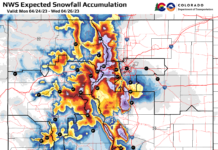Property owners in Grand County are going to see a significant increase in their official property values and while that means a gain in asset value for those property owners, those values may relate to an increase in property taxes.
Notices of property valuation will be mailed to all property owners on May 1. Increases in value should be expected by taxpayers throughout the entire county.
Grand County is a large county with a lot of variation in property types and value, Grand County Assessor Tom Weydert said, so the increases cover a wide range. It is impossible to give an exact figure because of that variety, Weydert said, but the increase in value for residential property in the county averages between 20-30 percent. Depending on the location and factors related to each specific property, some increases will be lower than 20 percent while some are higher than 30 percent.
“We understand that these increases will have a significant impact on individual property owners,” Weydert said. “We live in a cyclical economy and these increases are a reflection of an upward trend in that cycle.”
The determination of property values is a detailed process, one that ensures the county assessor’s office follow strict guidelines which are governed by state statute. However, the basic factor driving the increase in property values is market value and that is set by actual property sales.
The re-valuation is done every odd-numbered year and, for this cycle, the assessor’s office must look at the sales price of property sold during the time period starting on July 1, 2016 and ending on June 30, 2018.
The appraisers in the assessor’s office are required by state statute to use those sales prices to determine the value of all property at the end of the evaluation period. If an upward time trend has been determined during the applicable period, the sales prices that are used to determine property values will be “time trended” upwards to represent the value of that property on June 30, 2018.
“The prices that have been paid for property are directly responsible for the significant increase in value,” Weydert said. “Our appraisal process is a reflection of what has happened in the market place.”
Property owners do have the right to appeal their valuation. Instructions and timelines for that process are included on the notice of valuation. “We worked hard to come up with the appropriate value for property in this county,” Weydert said. “However, this is a mass appraisal process and not every property will fit exactly into our statistical and modeling analysis.”
A protest is not a protest about higher taxes, Weydert said. “It is an attempt to demonstrate that your property’s estimated market value is inaccurate.”
There may be a chance that the county’s record need to be updated. For example, the number of bathrooms or the square footage of your house may be inaccurate. Typically, Weydert said, property owners believe their value doesn’t accurately reflect the market. “The appraisers in our office use sales data to estimate the market value of your property,” Weydert said. “To dispute that value, a property owner is advised to provide evidence that similar properties have sold for less (or more) than the estimated market value for his or her property.”
The first step of the appeal process is that the property owner return the postcard that comes with the notice of valuation. On that postcard is space to specify a reason for the appeal. “Remember, the appeal process is about demonstrating that your property’s estimated value is inaccurate,” Weydert said. “If you believe your value is inaccurate, then simply provide us with your evidence and rationale.”
Each appeal will be answered with a response from the assessor’s office. The appraisers in the office will evaluate the appeal and either present an adjustment to the valuation or deny the appeal.
Before hitting the panic button, though, realize there are two parts of the Colorado Constitution that could moderate rising tax bills.
The Gallagher Amendment, adopted in 1982, mandates that residential property tax revenues comprise 45 percent of the statewide total, while 55 percent must come from commercial and other classes of property. The amendment further mandates the rate for non-residential property be fixed at 29 percent. This mandate over time has forced the residential property assessment rate downward to 7.2 percent.
The state Legislature sets that percentage, and Weydert says a preliminary study suggests the residential rate may be lowered to 7.15 percent.
The assessed rate of property is just part of the picture, Weydert said. The other part of the picture is the mill levy rate which has been established by the voters in the various entities and special districts in the county. The budget of each of those organizations is a factor of the assessed valuation and the mill levy for that organization. It is the responsibility of all property owners to be a part of that budget process, Weydert said, to become informed about the quality and cost of services provided by that organization. All that said, the exact impact of the reappraisal won’t be known for months — after appeals are decided by June 30, after Weydert certifies final assessed values to taxing agencies by Aug. 25 and after taxing agencies set mill levies based on compliance with TABOR by Dec. 15.
Weydert said his office is scheduling meetings early in May to answer questions and address concerns. Hot Sulphur Springs Town Hall on Monday May 6th, Kremmling Library on Tuesday May 7th, Wednesday the 8th at the Fraser Library, Thursday the 9th at Granby Library, and Friday in Grand Lake at the Grand Lake Center. All meetings are from 6 to 7:30 pm.
In looking ahead, the base period for the 2021 re-evaluation started last July. In looking at sales prices all around the county, Weydert said, prices are still on the rise.









